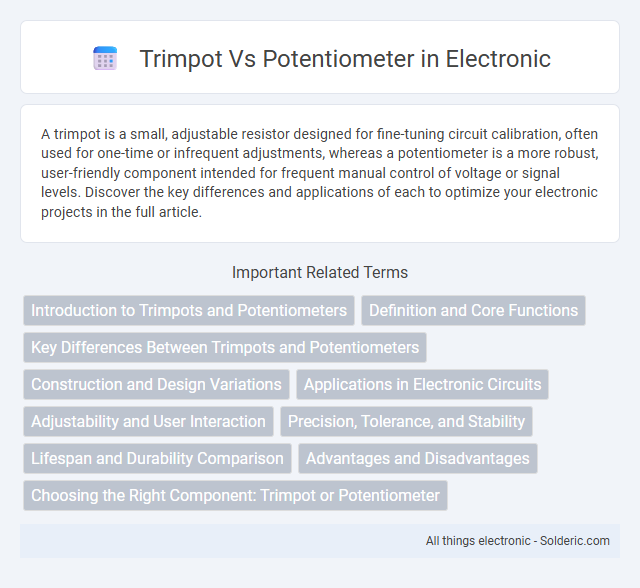A trimpot is a small, adjustable resistor designed for fine-tuning circuit calibration, often used for one-time or infrequent adjustments, whereas a potentiometer is a more robust, user-friendly component intended for frequent manual control of voltage or signal levels. Discover the key differences and applications of each to optimize your electronic projects in the full article.
Comparison Table
| Feature | Trimpot | Potentiometer |
|---|---|---|
| Definition | Small, adjustable resistor for fine-tuning circuits | Variable resistor with a shaft for user control |
| Size | Compact, miniature | Larger, ergonomic for manual adjustment |
| Adjustment Method | Adjusted with a screwdriver or tool | Manually adjusted by rotating the shaft |
| Typical Use | Calibration, fine-tuning in circuits | Volume, brightness control, user interface |
| Durability | Limited adjustment cycles | Designed for frequent adjustments |
| Mounting | PCB mount | Panel mount or PCB mount |
| Cost | Generally lower cost | Higher cost due to size and usability |
Introduction to Trimpots and Potentiometers
Trimpots and potentiometers are variable resistors used to adjust electrical signals in circuits. Trimpots are small, low-power devices designed for precise, infrequent settings, often used in calibration tasks. Potentiometers are larger, user-adjustable components allowing continuous control over voltage, commonly found in audio equipment and control panels.
Definition and Core Functions
Trimpots and potentiometers are variable resistors used to control voltage and current in electronic circuits, with trimpots designed primarily for fine-tuning and calibration purposes. Potentiometers typically feature an adjustable knob or slider for user interaction, allowing continuous regulation of electrical parameters, while trimpots usually require a tool for adjustment and are set less frequently. Your choice depends on the need for either convenient user control or precise, stable calibration in your circuit.
Key Differences Between Trimpots and Potentiometers
Trimpots and potentiometers both function as variable resistors, but trimpots are designed for precision adjustments and are typically set during device calibration, whereas potentiometers allow for frequent manual adjustments by the user. Trimpots are smaller, often mounted on circuit boards for fine-tuning, while potentiometers feature a larger knob or slider for easier user control. Your choice depends on whether you need a stable, rarely changed resistance or a user-friendly control for regular adjustments.
Construction and Design Variations
Trimpots, also known as trimming potentiometers, are compact, adjustable resistors designed primarily for fine-tuning and calibration within electronic circuits, featuring a multi-turn screw adjustment mechanism for precise control. In contrast, standard potentiometers incorporate a slider or rotary knob for user-friendly, variable resistance adjustments, often used in volume controls and general settings. Construction differences include trimpots' sealed, small, and low-profile housings optimized for circuit board mounting versus potentiometers' larger, more robust designs suited for manual operation and frequent adjustments.
Applications in Electronic Circuits
Trimpots are primarily used for calibration and fine-tuning in electronic circuits due to their small size and limited adjustment range, ideal for setting reference voltages or bias currents. Potentiometers offer more versatile control with larger adjustment ranges, commonly used for user interfaces such as volume controls and light dimmers. Both components play critical roles in circuit design, with trimpots favored for precise, rarely changed settings and potentiometers for regular user adjustments.
Adjustability and User Interaction
Trimpots offer precise adjustability with limited rotation, making them ideal for fine-tuning circuits during manufacturing or maintenance. Potentiometers provide broader adjustability and user-friendly interfaces suited for frequent manual adjustments in consumer devices. The choice depends on whether the application requires infrequent calibration (trimpot) or regular user interaction (potentiometer).
Precision, Tolerance, and Stability
Trimpots offer higher precision and tighter tolerance compared to standard potentiometers, making them ideal for fine calibration tasks where stability over time is critical. Their compact size and adjustability allow for more accurate resistance settings, ensuring reliable performance under varying environmental conditions. Choosing a trimpot can enhance your circuit's stability by minimizing drift, whereas potentiometers are better suited for general adjustments requiring less strict tolerances.
Lifespan and Durability Comparison
Trimpots typically offer a shorter lifespan due to their design for occasional adjustment and lower durability under frequent mechanical stress compared to potentiometers. Potentiometers are engineered for regular use with higher-quality materials and robust construction, resulting in longer operational life and increased reliability in continuous adjustment scenarios. The choice between trimpot and potentiometer hinges on application demands for adjustment frequency and expected device longevity.
Advantages and Disadvantages
Trimpots offer compact size and precise adjustment, making them ideal for calibration in tight circuit spaces, but they generally have lower power ratings and less durability compared to standard potentiometers. Potentiometers provide greater robustness, higher wattage tolerance, and ease of manual adjustments for user interfaces, yet they are bulkier and less suitable for fine-tuning in manufacturing settings. Selecting between a trimpot and a potentiometer depends on the application requirements such as space constraints, adjustment frequency, and power handling capabilities.
Choosing the Right Component: Trimpot or Potentiometer
Choosing between a trimpot and a potentiometer depends on the application requirements for adjustability and durability. Trimpots are compact, designed for infrequent calibration within circuits, and provide precise resistance adjustments in a permanent setting. Potentiometers offer user-friendly manual control with higher durability for repeated adjustments, making them ideal for interfaces requiring regular tuning or variable control.
Trimpot vs potentiometer Infographic

 solderic.com
solderic.com